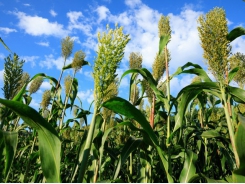Genealogy of important broiler ancestor revealed

Further analyses may reveal more about importance of genetic drift and selection in closed populations.
Adult females of the HWS and LWS bodyweight-selected White Plymouth Rock lines. Photo Credit: Christa F. Honaker
A new study examines the historical and genetic origins of the White Plymouth Rock chicken -- an important contributor to the modern meat chicken (broilers). Researchers at Uppsala University in Sweden, The Livestock Conservancy and Virginia Tech in the U.S. have used genomics to study breed formation and the roots of modern broilers.
According to the announcement from Uppsala University, the mid-19th century was time of rapid change for poultry breeders, as newly imported chickens from Asia were crossed with American landrace chickens and specialty breeds from Europe to establish new breeds and varieties. Those breeds and varieties were then standardized by the American Poultry Assn. beginning in 1873.
With contributions by multiple breeders using different strategies, the histories of these American breeds are sometimes unclear or inconsistent, the announcement said.
Two well-known lines of chickens developed at Virginia Tech represented the White Plymouth Rock. The HWS and LWS lines have been selected since 1957 for high and low bodyweights, respectively, and are considered representative of the White Plymouth Rock breed as of the mid-20th century in the U.S.
The research team sequenced DNA from HWS, LWS and the eight breeds generally considered to have been used to develop the White Plymouth Rock, the announcement said. The researchers then ascertained the percentage of genetic contribution made by each of the founding breeds. Furthermore, by measuring each breed’s contribution to individual chromosomes, they were able to determine contribution to specific traits on those chromosomes. Contributions to the male and female chromosomes shed further light on the breed history.
The results confirmed that the Dominique -- a very old American breed -- was the major contributor to the Plymouth Rock. Dominique, Black Java and Cochin breeds contributed to the maternal ancestry, while contributions to the male ancestry included Black Java, Cochin, Langshan, Light Brahma and Black Minorca, the researchers said.
Perhaps coming as a surprise, the researchers said the proportional contribution of each of the founders is consistent with early breed history and records, despite selection in the 19th century for white feathers, clean legs, a single comb and yellow skin and selection in the early 20th century for increased body size and egg production.
Differences in the overall ancestral contributions to the HWS and LWS lines were minor, despite more than 60 years of selection for eight-week bodyweight. Contributions to individual chromosomes were more apparent, and subsequent analyses may provide more insights into the relationship between ancestry in specific chromosome regions and long-term selection for bodyweight differences, the announcement said. Such analyses may have implications for genetic contributions to today’s broilers.
The livestock and poultry breeds of today are the result of foundation, isolation (genetic drift) and selection, both natural and intentional, the researchers said.
“Genomic analysis has proven to be a good tool for understanding genetic contributions to breed development. Through additional study of founder contribution to chromosomes and genes, such analyses may also reveal more about the importance of drift and selection in closed populations. Such work also highlights the importance of conserving pure breeds and selected lines of chickens," said Örjan Carlborg, professor at the department of medical biochemistry and microbiology at Uppsala University, and lead author of the study.
Có thể bạn quan tâm
Phần mềm

Phối trộn thức ăn chăn nuôi

Pha dung dịch thủy canh

Định mức cho tôm ăn

Phối trộn phân bón NPK

Xác định tỷ lệ tôm sống

Chuyển đổi đơn vị phân bón

Xác định công suất sục khí

Chuyển đổi đơn vị tôm

Tính diện tích nhà kính

Tính thể tích ao hồ



 Low vitamin D levels? Shine a black light…
Low vitamin D levels? Shine a black light…  Strategy to reduce the immunotoxic effects of aflatoxins…
Strategy to reduce the immunotoxic effects of aflatoxins…